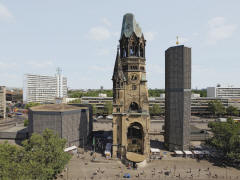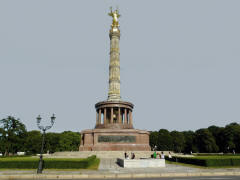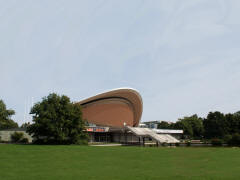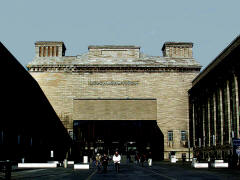|
Page 1 2 3 4 5 6 7 8 9 10 11 12 Berlin Wednesday,
9 October. We were up at 6:45 and had breakfast at 7:30.
The bus left at 9:00 to take us on a tour of Berlin.
Just a couple blocks from our hotel, we passed the
Kaiser Wilhelm Memorial Church as we cut over to get on
the Ku-damm. The original church, built in the 1890s,
was destroyed by Allied bombs in 1943. When the modern
new church was built (1961), the damaged spire and foyer
of the old church were incorporated into the design.
The bus turned north at Wittenburg Platz and entered the Tiergarten. The Tiergarten (Animal Garden), once a hunting ground of the Electors of Brandenburg, is now mostly a huge park, but the eastern part of it also is the site of many government buildings. The Tuergarten extends all the way from the Zoo subway stop to the Brandenburg gate. Along the way we passed the Victory Column (1873) in the center of the Grosser Stern (Great Star) traffic circle, Then we left the main road and began crisscrossing the Government District. We passed Bellevue Palace (1786, the Presidential Residence since 1994) and the House of the Cultures of the World (1957), a gift from the United States, nicknamed the "pregnant oyster" for its unique design. We passed the Reichstag (1894), the old parliament building, multiple times, so we saw it from all angles. When it was badly damaged by fire in 1933, Hitler blamed it on the communists and his other enemies and used the disaster to enhance his power. After Berlin once more became the capital of a unified Germany, the building was finally restored (1990-1999) and once again is the meeting place of the German parliament (Bundestag). Right next to the classic old Reichstag is the incongruous modernistic Bundestag office building (2001). We also drove by the equally modernistic Chancellory (2001), the largest government headquarter building in the world, ten times the size of the White House. (In Germany the Chancellor is the head of the government, like a Prime Minister; the President is the head of state, a mostly ceremonial office.) The bus briefly crossed the Spree River on a bridge near the ultramodern main train station. We crossed back on the next bridge, the Oberbaum. This bridge, originally opened in 1902, was bombed during World War II and then closed during the Cold War. The bridge was restored and reopened in 1997 with a new steel middle section designed by the Spanish architect Santiago Calatrava in 1994. It's a double-decker, with Auto and pedestrian traffic on the lower part and S-bahn trains above. The bus then drove us through came to Potsdamer Platz. Before World War II, this bustling square was the heart of Berlin. First destroyed by Allied bombing, then bisected by the Berlin Wall, it became a waste land. Since the Wall came down, it has been developed with luxurious modern commercial buildings, and once more is considered the heart of Berlin. Our bus looped around to 17 June Street, passed the Russian War Memorial (1945) and stopped at the Brandenburg Gate (1791). Jane and I had seen the Gate many times before but, because the Berlin Wall stood just behind it, we had never been able to pass through it into the Mitte district, the oldest part of Berlin. Now the bus dropped us off on the west side, and we walked through it to Pariser Platz and Unter den Linden on the Mitte side. Jutta led us a short way down Unter den Linden, through the Academy of the Arts building, and a couple blocks more to the Holocaust Memorial (2004). The Memorial covers nearly five acres and consists of 2,711 gray concrete slabs of varying height in a grid pattern on sloping ground. It is understandably controversial.
Our bus met us at
the far end of the Memorial and took us a few blocks to
Niederkirchner Street. The longest remaining section of
the Berlin Wall runs for nearly a full block on that
street. Despite present efforts to preserve it, the
"wall-peckers" still come by, mostly by night, and
chisel out pieces as souvenirs. We also visited the
Topography of Terror memorial and museum on the same
street. Its exhibits document some of the worst Nazism
crimes.
Our next stop was at Checkpoint Charlie.
The original guardhouse and its American troops are long
gone. (The little building is now in the Allied Museum
in Dahlem.) But the site was too good a tourist
attraction to disappear. Now a replica guardhouse on the
site is manned by actors playing U.S. Army Military
Police, and a replica signs warns that "You are now
leaving the American sector."
Back on the bus, we all turned in the "Whisper" headsets we had used throughout the tour. The bus continued our city tour, dropping off those interested at the Holocaust Museum (opened 2001). We thought it would be very interesting to see, but we had been to the one in Washington, D.C. We decided that we would rather spend our limited time at Museum Island.
We passed
Gendarmen Markt (1773), a large square featuring the
Konzert Haus (1821) and two similar-looking Cathedrals,
one French (1705), the other and German (1708). Most of
the buildings in the square were destroyed in World War
II, but all have been restored. This was a part of
Berlin we'd never seen before.
The bus continued on to Unter den Linden, then up Bode Street to Museum Island, where we were dropped off in front of the National Gallery. The Berlin Cathedral (first built 1451, present structure 1905) was half a block to our rear. We were on Museum Island, but nothing looked familiar even though I had been there several times (and Jane once). I guess I had always taken a taxi directly to the Pergamon Museum before. That was the museum I had visited most often. A major renovation of all the museums began after reunification, and there still was a lot of construction going on. Everything looked so different. Even the collections in the various museums had been changed.
On our left facing the Nation
Gallery was the New Museum (1859), only recently
restored (2009). It had been mostly rubble when I last
visited. (It now houses the bust of Nefertiti that I had
seen three times at the Dahlem Museum.) We finally found
a back corner of the Pergamon and followed the building
until we found the entrance. That was completely changed
as well.
We had decided not to try to go through any of the museums now because we really didn't have enough time, but we did visit the gift shop in the Pergamon. I had shopped often in the old one and usually bought whatever reproductions they had, but their stock was always limited. I expected that the new gift shop would have everything the old one ever had and much more. I was disappointed to find that it had only a few small reproductions, and those were mostly of jewelry. We left Museum Island and walked along the Spree
River back to Unter den Linden. We were unhappy to see
that the roadbed of that avenue was completely torn up
and was filled with pile drivers and other noisy
machinery. A new subway line was being built under the
street. We had planned to spend the afternoon browsing
leisurely along this normally beautiful avenue back to
the Brandenburg Gate, but the walk was anything but
pleasant under these conditions.
It was nearly 1:00 and we didn't see any restaurants ahead, so we decided to have lunch in the cafeteria of the German Historical Museum (2006) located in the Zeughaus (Arsenal)(1695). Afterwards we browsed the exhibits in the huge lobby.
Then, continuing
down Unter den Linden, we passed the Neue Wache (New
Guard House) (1816). It had been a war memorial since
1931, although the dedication had changed with the
times. When we last saw it, it was the Memorial to the
Victims of Fascism and Militarism and was guarded by
goose-stepping East German (GDR) soldiers. Since 1993 it
has been a Memorial to Victims of War
and Dictatorship.
The
next building on our side was Humboldt University
(1810). Bebel Platz, (formerly Opern Platz) (1743) was
right across the street.
Bebel Platz is the site of St. Hedwig's Cathedral (1773,
rebuilt 1963 after destroyed in World War II)), the Old
Library (1780) (originally the Royal Library) and
the Berlin State Opera (Staatsoper)(1844). I had
attended a performance of Aida at the State Opera in the
1980s while in Berlin on official business.
We were still in front of Humboldt University when it suddenly started to rain. At the same time, a city bus headed for the Zoo Station was pulling up to the curb near us. It was only about 1:45, much earlier than we had intended to leave this area, and we still had a few blocks to go to the Brandenburg Gate. But there was no shelter nearby, and besides it was so unpleasant on Unter den Linden with all the construction noise, we made a snap decision to get on the bus. Within just a few minutes, the rain stopped, but we were committed.
When we
got off at the Zoo Station. We walked to the back of the
station and found a wide path through to wooded area
along side the zoo. There were frequent open areas along
the fence where we had a good view into the zoo. We saw
several species of domesticated animals (small donkeys,
goats, miniature horses), some not even in enclosures,
being petted by children and adults alike. After a
while, the path began to look very deserted and possibly
risky, so we turned back. We took a back street to the
hotel and got back around 2:30.
We rested a little and repacked our suitcases for tomorrow's departure. We all met at 5:00 for a farewell drink and to say our goodbyes. At 6:00 the buses took both groups to the Nolle Restaurant back in the Mitte district. The restaurant was built under one of the arches supporting the elevated S-Bahn station Friedrich Strasse. It was a very large restaurant; there were about 90 people in our party alone, and there were many others there as well. Understandably, they did not want anyone deviating from the planned menu. That turned out to be a problem for our Jewish friends because both the soup and the entree contained pork. It took time, but they eventually got it sorted out. The main course, incidentally, was meat loaf. While it was very good, many of us were surprised that it would be chosen for our last meal together. Usually the last meal is the most lavish of the trip.
We left the Nolle about 8:00 and got a
pleasant surprise on the ride back to the hotel. The
Festival of Lights, an event that occurs in Berlin every
October, was underway. As our bus left the restaurant,
it turned onto Unter den Linden going toward the
Brandenburg Gate. When I first saw the Gate, it looked
like it was covered with roses. In a few seconds the
roses were gone and the Gate was covered in variegated
horizontal stripes. The Reichstag was also bathed in
colored light, as were various other buildings in the
distance. When the bus reached the Grosse Stern traffic
circle, the Victory Column had various line-figures
projected on its length. Our driver went around the
circle multiple times so we could enjoy the view. Then
the Column turned a solid deep blue on our last lap.
Neither Jutta nor our local guide had mentioned the
Festival of lights in advance. We got back to the hotel about 8:00. We gave Jutta her tip because we wouldn't see her in the morning. Fortunately, we had managed to get by despite the expired ATM card, saving just enough cash for a small snack at the Berlin airport and the taxi from the Newark airport. We finished packing before retiring. Page 1 2 3 4 5 6 7 8 9 10 11 12
Copyright © 2000-2023 DarrellPeck.com All rights
reserved. | |||||||||||||||||









